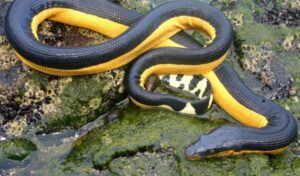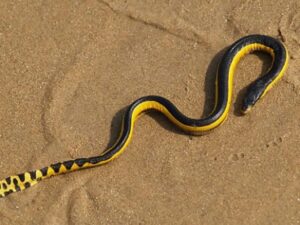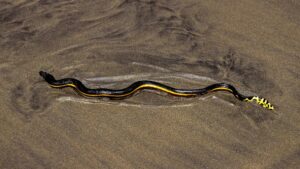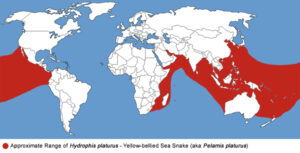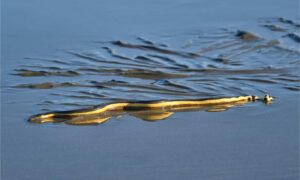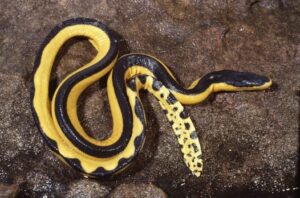The yellow-bellied sea snake is venomous found in the tropical waters of all oceans except the Atlantic Ocean. It was a part of the Pelamis genus for several years until molecular evidence suggested that it is a part of the Hydrophis genus.
Swedish taxonomist Car Linnaeus described this snake in 1766, referring to it as Anguis platura, with ‘Anguis’, translating to a snake. The word platura combines the Greek words platys and oura, meaning flat tail. It was renamed Pelamis ornate by French zoologist Francois Marie Daudin and placed under the genus Pelamis. Ferdinand Stoliczka, a Moravian paleontologist, called it Pelamis platurus using an incorrect ending, adding us for platurus instead of a.
Scientific Classifications
- Suborder:Serpentes
- Family: Elapidae
- Genus:Hydrophis
- Species:H. platurus
Conservation Status
Description
Size
Males reach 28 inches with a tail length of around 3.1 inches. The female snakes are bigger, with a slightly longer tail length of 3.5 inches.
Color and Appearance
One of their distinguishing features is their yellow underbelly, as evident from their name. They also have a black or bluish-brown back. The colors on the dorsal and ventral parts are sharply demarcated. Several black bars or spots can be spotted on the ventral parts extending up to their tail. There are color variations, with the snakes sometimes all-yellow. The undersides may even appear darker than their upper part.
They have a medium-sized compressed body with a narrow head, elongated snout, and juxtaposed scales. In fact, on their body, they have hexagonal scales that appear small and smooth. On the head, the scales are big and arranged in a regular pattern. The scales on their mid-body are arranged in rows of 47 to 69, while they have 264 to 406 ventral scales.
Are They Dangerous to Humans
Humans don’t quite encounter the yellow-bellied sea snake except when an injured or sick snake has reached the shores. Though they aren’t fit or healthy enough to attack, these snakes could pose a threat and bite if handled roughly. Because of their short fangs, only a small amount of venom is likely to be injected into the victim’s body. Yet, their venom contains neurotoxins and isotoxins, so immediate medical treatment is needed to combat the severity of symptoms. The bite may initially be painless and cause no discoloration or swelling. As the symptoms progress, it may lead to muscle pain, drooping eyelids, vomiting, drowsiness, and even paralysis or death under severe circumstances.
The antivenom used to neutralize the venom of these snakes include that of the beaked sea snake or tiger snake.
Yellow-bellied Sea Snake at a Glance
Distribution
They have a wide distribution found in the tropical portions of the Indian Ocean and the Pacific Ocean.
Habitat
They are the most pelagic among other sea snakes, primarily seen in open oceans close to reefs and coasts. A small population was even spotted near mangrove swamps, suggesting that these snakes may, at times (though rarely) occupy intertidal (meeting point of land and sea) habitats. They often move in aggregations on the water surface, a strategy they adopted to hunt prey.
Lifespan
Though the records of their lifespan at sea are unrecorded, they may survive for 2-3 years in captivity.
Predators
They don’t have too many predators, which is quite unlikely among sea snakes. No predatory behavior has been detected, even in areas where these snakes have an increased population and coexist with big fish, marine mammals, and sea birds. Their bright color gives the impression that they are highly dangerous and have an unpleasant taste. In experiments, marine fish were offered pieces of the skinned snake but refused it immediately. Some that were tricked into eating the meat regurgitated it in no time.
Diet
In their wild habitat, the main diet of the yellow-bellied sea snake is fish. It either hunts stealthily or waits quietly for the fish to come within its reach. It then grasps the fish from behind so that it comes within its mouth’s range. In captivity, it eats live or dead fish and also frogs. While feeding, they have a typical trait of thrusting their body forward and biting at whatever comes in their way, including other snakes. If they find their food dangled above their head, they will go to the extent of thrusting their head out of the aquarium to acquire it.
Reproduction
They choose warm waters as their breeding grounds, with the females being ovoviviparous. Their average gestation period, as seen in snakes bred in captivity, is around five to six months. The females of the yellow-bellied snakes bear 2-6 youngs in a go with an average length of around 250mm. The young are fat-bodied at birth and begin feeding right after being born. American herpetologist Raymond Lee Ditmars mentions that females mostly give birth to live young in tidal pools.
Interesting Facts
- One of its distinguishing traits is its ability to swim backward to hunt prey. These snakes detect prey by sensing their vibration.
Source
ustraliangeographic.com.au, i.guim.co.uk, i.natgeofe.com, californiaherps.com, a-z-animals.com, media.australian.museum

